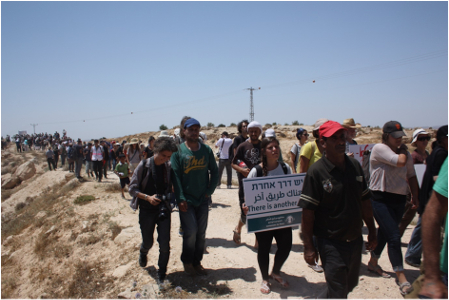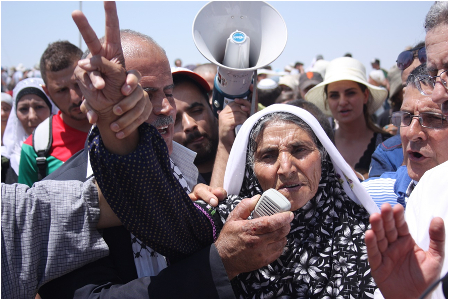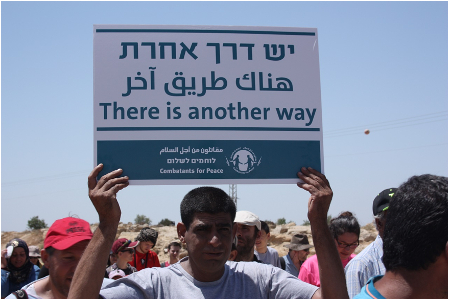Strong Israeli Presence
On Friday 24th July, 2015, busloads of activists, academics, and religious leaders ventured into the heart of the West Bank and descended on the southern Hebron Hills, in a momentous showing of solidarity for the Palestinian villagers of Susiya. People came from across the globe, and more importantly, across Israel, to show their support for the dire situation of the Palestinian residents of the threatened village. A strong and prominent showing of Israeli support for the Palestinian village was palpable as buses came from as far as Tel Aviv and Jerusalem.
The protest itself was peaceful, as expected. Hundreds participated in the March as they made their way through the village. Along the way several speeches were made by the organizers of the protest, all of which amounted to how Susiya was here to stay. Finally, the protests displayed a huge banner, decorated in the colors of the Palestinian flag, in front of the nearby Jewish settlement which reiterated this same sentiment.

Approximately 500 protesters consisting of Palestinians, Israelis and international activists were present. (Photo: Charlie Elkins)
Susiya was under threat of being bulldozed for a third time. The first being in 1986, when the archaeological remains of an ancient Jewish synagogue were discovered under the village. Now a well-polished tourist attraction in its own right, the ancient synagogue’s visitor center overlooks the bleak-looking set of dilapidated tents which compose Palestinian Susiya. The second time was in 2001, when the army moved them in reaction to Palestinians killing an Israeli from the neighboring settlement. This time, the villagers were set to have their makeshift tents demolished since they were deemed illegal by the Israeli authorities.
Violation of Human Rights
According to the 1993 Israel-Palestine Oslo accords, Susiya falls under Area C of the West Bank which Israel is assigned full control over. While Israeli authorities maintain the villagers did not acquire the necessary planning permission for the village, residents of Susiya argue gaining such authorization is near enough impossible. Such complaints are not only characteristic of Susiya but are echoed throughout the Palestinian neighbourhoods of east Jerusalem.
Rabbi Arik Ascherman, Executive Director of Rabbis for Human Rights, stated the NGO had been working with and legally representing the people of Susiya since 2001. He compared the plight of Susiya’s residents to the Jewish holiday of Tisha B’Av, which commemorates the destruction of the first and second temples and which also took place over the weekend. “What we feel as a national tragedy, anyone we see losing their homes and having their lives wiped out, we feel on a personal communal level.” Rabbi Ascherman further likened the ongoing situation in Susiya to the parable Kivsat Harash (The Poor Man’s Lamb) where Prophet Nathan tells King David in the Bible, of the rich and poor man, in which the powerful takes from the weak: “This is what this is. It’s Kivsat Harash. It’s taking from people who already don’t have anything.” According to Rabbi Ascherman, this basic wrong goes some way to explaining why the protest itself was so successful and garnered such international support. “You cannot let politics trump human rights,” he argued.

A protestor calls for peace and solidarity. (Photo: Charlie Elkins)
Apartheid Policies
Whatever the reasoning behind why the protest was successful, it was personally difficult to fathom what exactly the Israeli government is fighting over. When coming into Susiya, you are greeted by a set of gleaming buildings, all hooked up to the grid where the settlers live, and then half to one kilometer further down the road, you come across a rag tag collection of ramshackle tents; held together with makeshift materials such as tires and rocks. According to local villagers, they are prevented from residing on any of the surrounding land which for the most part is either farmland or completely desolate. Thus they are being slowly squeezed into tighter and tighter areas. Where exactly are they supposed to go? How are they supposed to rebuild without permits? Unfortunately, as Rabbi Ascherman pointed out, “They have no say in where they live.”

Palestinian tents which the Israeli authorities deemed illegal (Photo: Charlie Elkins)
It is the unjustness inherent in the answer to these questions which compel people, like Jamal from the Stop the Wall Campaign, to compare Israeli practices to relocate Palestinians into smaller enclaves to the Bantustans in South Africa. “They want their land to expand the settlements,” Jamal argued. “This is what we talk about when we talk about Apartheid. They are chasing the indigenous people from here.”
Apartheid however, was ultimately brought to an end because of international pressure. And Israeli NGO activists, such as Adam Keller of Gush-Shalom, happily acknowledged that “this was the most successful demonstration in the West Bank for decades.” And as the BDS movement gradually gets bigger. And as international bodies like the State Department and EU continue to denounce Israel’s actions, only time will only if Susiya can prove to be a catalyst comparable to Rosa Parks’ actions which sparked the civil rights movement, and initiate a wave of sentiment that what is occurring throughout the West Bank and Palestine is not only morally reprehensible, but must be brought to an end as soon as possible, if peace is to prevail.

“There is another way.” A protestor conveys the simple message underlining the protest.
